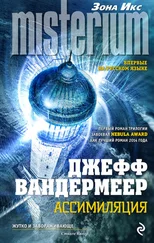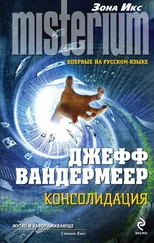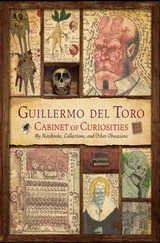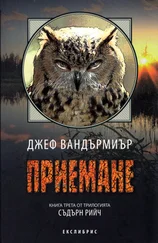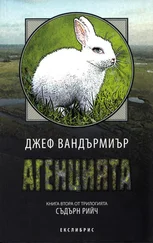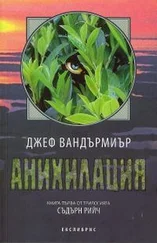Джефф Вандермеер - The Thackery T. Lambshead Cabinet of Curiosities
Здесь есть возможность читать онлайн «Джефф Вандермеер - The Thackery T. Lambshead Cabinet of Curiosities» весь текст электронной книги совершенно бесплатно (целиком полную версию без сокращений). В некоторых случаях можно слушать аудио, скачать через торрент в формате fb2 и присутствует краткое содержание. Жанр: Фэнтези, на английском языке. Описание произведения, (предисловие) а так же отзывы посетителей доступны на портале библиотеки ЛибКат.
- Название:The Thackery T. Lambshead Cabinet of Curiosities
- Автор:
- Жанр:
- Год:неизвестен
- ISBN:нет данных
- Рейтинг книги:5 / 5. Голосов: 1
-
Избранное:Добавить в избранное
- Отзывы:
-
Ваша оценка:
- 100
- 1
- 2
- 3
- 4
- 5
The Thackery T. Lambshead Cabinet of Curiosities: краткое содержание, описание и аннотация
Предлагаем к чтению аннотацию, описание, краткое содержание или предисловие (зависит от того, что написал сам автор книги «The Thackery T. Lambshead Cabinet of Curiosities»). Если вы не нашли необходимую информацию о книге — напишите в комментариях, мы постараемся отыскать её.
The Thackery T. Lambshead Cabinet of Curiosities — читать онлайн бесплатно полную книгу (весь текст) целиком
Ниже представлен текст книги, разбитый по страницам. Система сохранения места последней прочитанной страницы, позволяет с удобством читать онлайн бесплатно книгу «The Thackery T. Lambshead Cabinet of Curiosities», без необходимости каждый раз заново искать на чём Вы остановились. Поставьте закладку, и сможете в любой момент перейти на страницу, на которой закончили чтение.
Интервал:
Закладка:
I stared at it, flabbergasted by the sheer mastery of workmanship. It could have been my previous unfortunate upchucking situation, as I rarely find myself at a loss for words, but I simply looked from the flask to the doctor, and waited.
“You see, Pasteur managed a reasonable solution for everyday basic bacteria, proving that they can’t pass a normal S bend. But you know he was killed by bacteria? Some say it was a stroke, but it was a bacterium with skilled navigational instincts, the kind of thing that laughs at the S bend, and is capable of trekking the fine capillaries, avoiding white blood cells, to attack at the most vulnerable areas in the brain. If he’d developed and learned about this flask in the years before I was born, he could have flummoxed the bacterium and lived longer.” He pointed to one of the sailor’s knots in the flask. “Here’s where they usually get caught, in the Figure of Eight Stopper. Just get outright lost. They rarely make it to the Angler’s Loop,” he pointed to the final knot.
It was true, the open tubes had varying amounts of grime near the opening, with dead bugs caught in the knots, and some even having followed the dead-end tube and gathered in the nipple, but all of the glass near the bulb to the flask was perfectly clean. It was even clean on the outside.
I pointed to the bulb. “What do you have in there?”
He waved his hand again, and I wondered how many of my interview questions he would brush away. “Something pure, I can tell you that, untouched by neither smart nor ignorant bacteria. I’m saving it for a special occasion.” He winked at me.
He took the flask with us inside and then offered me more tea, which I politely refused. We went on with the interview, not mentioning the cabinet again.
When I heard of his death in 2003, I wondered if he’d ever used what was in the flask, or if any of his journals would detail its contents. I also wondered if, perhaps, the flask died the same death as whatever crashed to the ground during my visit, and went from “something pure” to “something Paulette has to clean up before it spreads.”
Regardless, in perusing the recent auction catalog for the few unearthed cabinet items that survived the fire, I was struck by the following description: “ Glass abstract sculpture . Unknown origin. Composed of several curving and circular parts. Badly scorched and melted.” Unfortunately, the item had already been bought, and I could not act on my sudden impulse to own it.
1972: The Lichenologist’s Visit
As Told to Ekaterina Sedia by S. B. Potter, Lichenologist
As many readers of my novels know, I am also a professional lichenologist, and as such also part of a select and small community of fellow researchers. A few years back, when lichen taxonomy was revised based on new molecular data, it caused quite an upheaval—meaning that among fifteen people who’ve heard about it, ten cared. One of more vocal critics of the new taxonomic system was one S. B. Potter (not his/her real name), who has been active in the field for years, and who vigorously objected to redefining of some lichen genera. After one particularly heated Internet discussion, I received a snail-mail letter from S. B., containing the following story about a visit to Dr. Lambshead back in the 1970s. I’m afraid Potter has not communicated with me since, and I have no further information to offer. Although I do often wonder about the hand.—E. S.
I first visited Dr. Lambshead under a purely professional set of circumstances: I was recommended to him as the main lichenology expert of the area. At the time, Dr. Lambshead was just beginning to acquire a reputation for his acumen in the unusual diseases, and, like most men who are out to establish themselves, he was particularly impatient with anything that threatened to thwart his progress.
He called on me in secrecy, as if sharing his befuddlement would somehow diminish his stature: he had sent his letter with a messenger, the red wax of the seal reflecting the monogram of his signet ring, pressed with unnecessary vigor.
“Dear Dr. Potter,” he wrote in his meticulous, small and square letters, “I loathe to impose on your time, but I suspect that I’m in need of your expertise. I have a patient, one Mrs. Longford, who has developed a persistent cough, and then, a week later, strange greenish-grey splotches on the backs of her hands. I took a sample of the tissue and subjected it to microscopic examination, and to my surprise, the tissue appeared to be of a plant origin. I sent samples to my friends in Oxford, and they confirmed that the sample is indeed a lichen. They also forwarded your name and address to me, and in that regard I am now seeking your advice.
“Would you be able to identify the specimen, and possibly suggest the ways to alleviate my patient’s suffering? As time goes on, she is getting worse, with lichen now covering most of her extremities and spreading to her neck. Her cough has become rather fitful as well, and the sputum contains blood as well as lichen tissues. Yours sincerely, Dr. Thackery Lambshead.”
At the time, I had just begun to stumble toward the discovery of the link between seemingly innocuous lichens and the disease, but I was still ignorant of the darker nature of this connection; despite my ignorance, however, I had developed a sense of foreboding, as if the part of me that was more perspicacious than the rest was trying to warn me of some unknown danger. However, being a man of science, I had dismissed such irrational thoughts and decided to travel to Dr. Lambshead’s abode.
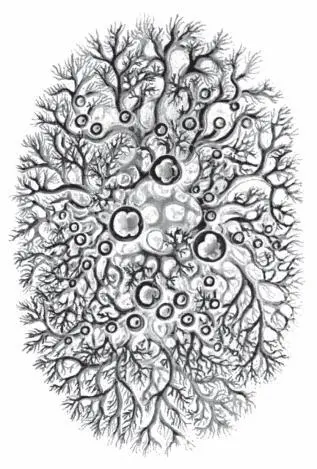
Lichen or Lambshead’s new fingerprint?
He resided in a large house, old and broad, fitting for a family doctor, I thought. The stones that composed its walls bore green and grey splotches, familiar to me—out of the habit, I gauged the age of the house by the lichen size. You see, lichens grow so slowly that many only increase their diameter by one millimeter a year; a lichen blemish the size of a penny is usually a hundred years old. The lichens on Lambshead’s home, however, were enormous—if I was to believe them, his house was much older than Hadrian’s Wall. Or at least the stones that composed it were—which was rather easier to believe, and I accepted this supposition as truth, reluctant (or unable) to continue thinking about the alternatives.
My next (unnoticed, unheeded!) warning came when the door swung open—it was a massive iron contraption, painted russet-red—and revealed a small man, his grey hair crusting over the dome of his variegated skull. His small eyes looked at me dully.
I asked to see the master of the house, and the man who answered the door turned, exposing the same powdery, unhealthily greenish aspect on the back of his neck as I had previously noted on his head.
Dr. Lambshead himself didn’t seem to belong in the foreboding and dark atmosphere of the house—he, as you would well know, was a jovial, hearty man, and his appearance dispelled any doubts I might have had about coming there. He had not a trace of the sickly pallor about him, and at once I scolded myself for my overly active imagination.
I looked at the samples and was able to confirm that they were indeed soredia (asexual reproductive structures) of a lichen; I was even able to guess its genus as Caloplaca, but the species eluded me. I promised to conduct additional chemical tests to tease out the exact nature of the specimen, and, with the business concluded, agreed to join my host for tea.
Over tea, I started to feel mildly ill, and was unable to much concentrate on the words of Dr. Lambshead. Blood pounded in my ears, muffling his voice, and my right hand was throbbing. I glanced at my fingers holding the teacup, and noticed that they had grown swollen and powdery; moreover, small brown fruiting bodies were staring to open on my fingertips, like tiny ulcers.
Читать дальшеИнтервал:
Закладка:
Похожие книги на «The Thackery T. Lambshead Cabinet of Curiosities»
Представляем Вашему вниманию похожие книги на «The Thackery T. Lambshead Cabinet of Curiosities» списком для выбора. Мы отобрали схожую по названию и смыслу литературу в надежде предоставить читателям больше вариантов отыскать новые, интересные, ещё непрочитанные произведения.
Обсуждение, отзывы о книге «The Thackery T. Lambshead Cabinet of Curiosities» и просто собственные мнения читателей. Оставьте ваши комментарии, напишите, что Вы думаете о произведении, его смысле или главных героях. Укажите что конкретно понравилось, а что нет, и почему Вы так считаете.

